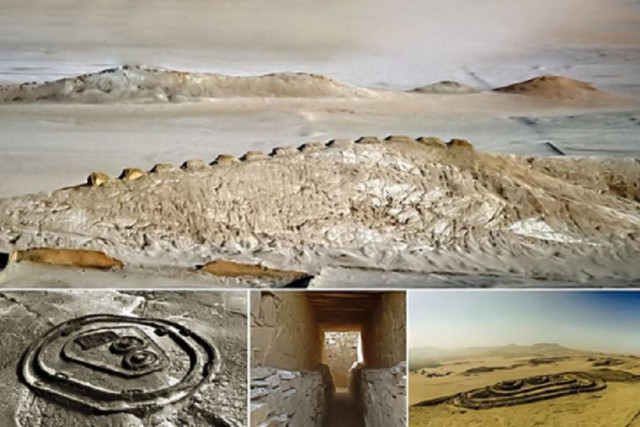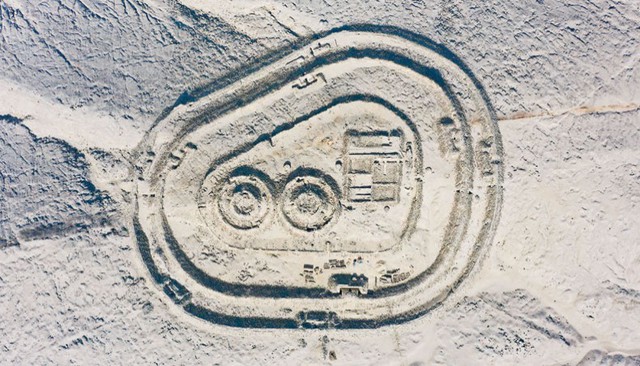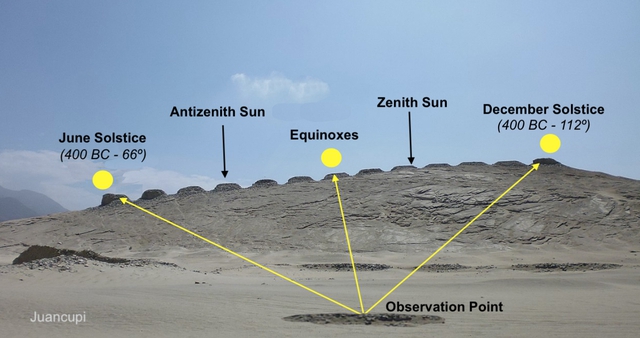These mysterious circles turn out to be ancient solar observatories of the Americas
The oldest solar observatory in the Americas was discovered off the coast of Peru. This is considered a ceremonial site providing evidence of “sun god religions” operating in South America 2,300 years ago.
Earlier, archaeologists discovered 4,000-year-old earthenware fragments in Peru that showed the image of a “scepter-wielding god” with rays emanating from his head, perhaps resembling the Sun (symbolized by the Sun (symbolized by the Sun). oldest religious statue of the Americas).
Historical records also describe “solar pillars” suggesting that the Incan civilization of South America observed the Sun – possibly helping to mark the time of sowing – around AD 1,500, although Those pillars are now destroyed.

Chankillo Observatory, built by an ancient civilization. Walled hilltop ruins about 400 kilometers north of Lima. The stone spiers at Chankillo have been known for a long time, but their astronomical value is not widely recognized and has long been forgotten by scientists. Then, in 2007, a study in the journal Science suggested the sequence of towers, they were erected between 200 and 300 BC for the purpose of “marking summer and winter” and Chankillo “as part of a solar observatory”.
The Incas also held public ceremonies to observe the sunrise or sunset at marked positions on the horizon, and ancient Inca chieftains also claimed their rule through ” kinship” with the Sun.
Peruvian archaeologist Ivan Ghezzi and study co-author Clive Ruggles of the University of Leicester, UK, say previous civilizations in Peru may also have observed the Sun, even the earliest. was in the fourth century BC.

High precision erected towers were placed to mark the various positions of the Sun. Their purpose was to time with precision the months, solstices and equinoxes – planting and harvesting seasons as well as religious holidays. Its operating structure resembles a giant clock, marking the passage of time over a period of one year.
They draw their conclusions based on the ruins at a walled Peruvian coastal site called Chankillo. Once thought to be a fortified ceremonial center or temple, researchers now suggest that the central complex of the ruins may have actually been used as a solar observatory.
In Chankillo, 13 equally spaced rectangular towers run the length of the 300m ridge like a spine, creating an artificial horizon. According to measurement data, 13 stone towers in Chankillo are located from 4.7m to 5.1m apart. At the time of construction, the towers were completely flat on top. Each tower has a different shape and size with a width of 70 – 130m and a height of up to 6m. They are spread across the Sun’s rising and setting positions, shifting north and south along the horizon over the course of a year.
On either side of the mountain are the ruins of observatories (there are two observatories on the east and west side) – which scientists say were used to observe the sunrise or sunset between the towers. On the summer solstice, the sun rises between tower 1 and a nearby mountain, and on the winter solstice, the sun rises around tower 13. This site may have been the site of various public ceremonies and festivals concerning the seasons and the Sun. Excavations have uncovered pottery, seashells and other artifacts near an opening in the western lookout.
The sun only appears for a day or two in each gap between the towers, and it takes six months to get from one end of the structure to the other. So maybe different towers are used to divide the year into regular intervals.

“Chankillo is a masterpiece of the ancient Peruvians. A masterpiece of architecture, a masterpiece of technology and astronomy. It was the cradle of astronomy in the Americas,” Ghezzi said. It could also be a place of worship to the Sun. Sites to the east and west of the tower contain the remains of objects used for ritual sacrifices. The observatory and its ceremonial appendages are protected by fortress walls made of stone, mud, and tree trunks. The complex spans about 5,000 hectares, Ghezzi said, but only about one percent of it has been studied.

“This is the only observatory in the ancient world that we know of that can be used to calculate the complete solar calendar in a year. A total of 13 towers are located in a position that coincides with the movement of the Sun in seasons of the year from two different points of view. This has no parallels anywhere in the Americas or in the world,” Ghezzi said. Chankillo is among the “infringed” locations; not by thieves but by nearby farmers who had long sought to expand their land and who took advantage of the lack of control to grow crops within the site’s boundaries .

Chankillo is the third Peruvian site to be included in the UNESCO World Heritage list this century. Previously, this title was given to Qhapaq Ñan – an extensive Inca road system – in 2014 and to Caral – the oldest city in the Americas – in 2009.
at Blogtuan.info – Source: genk.vn – Read the original article here


